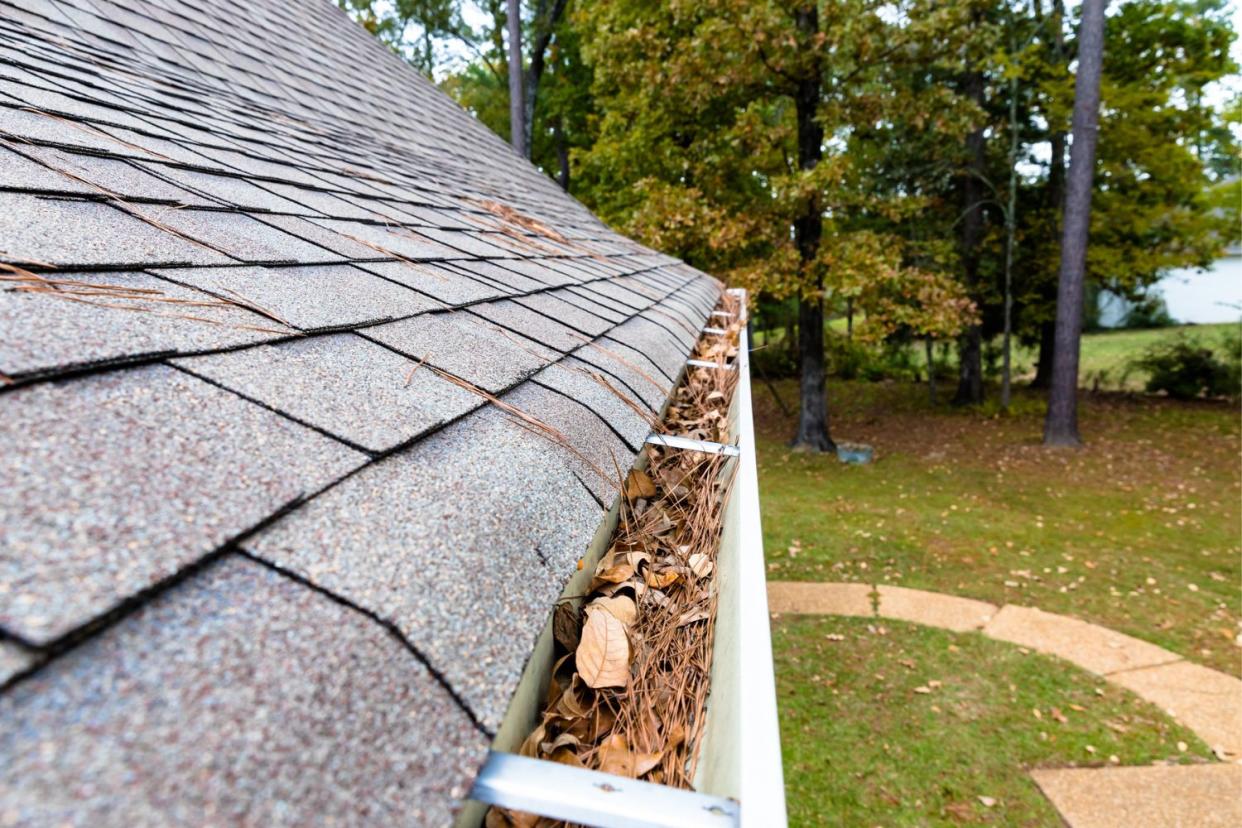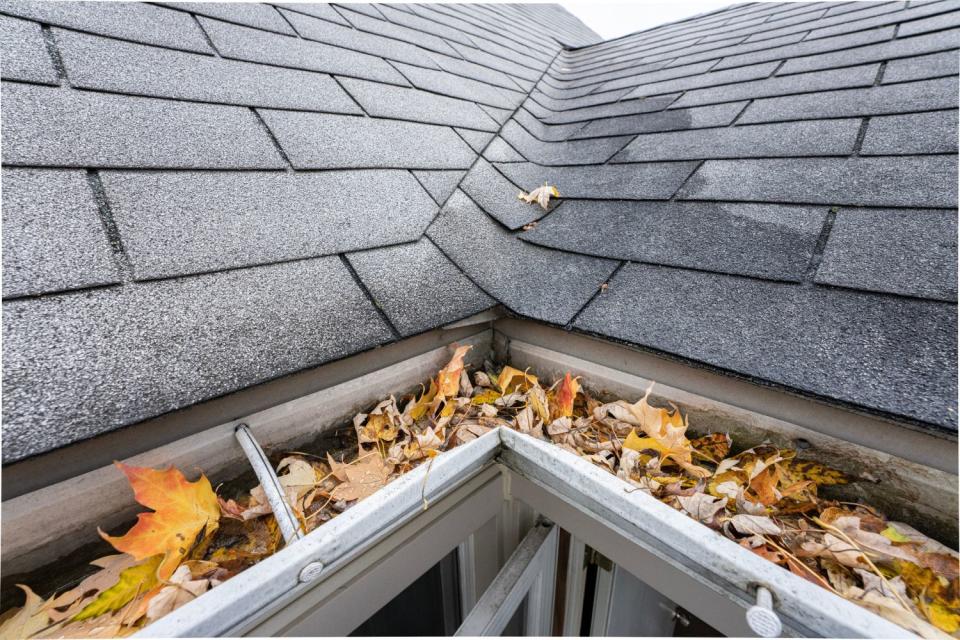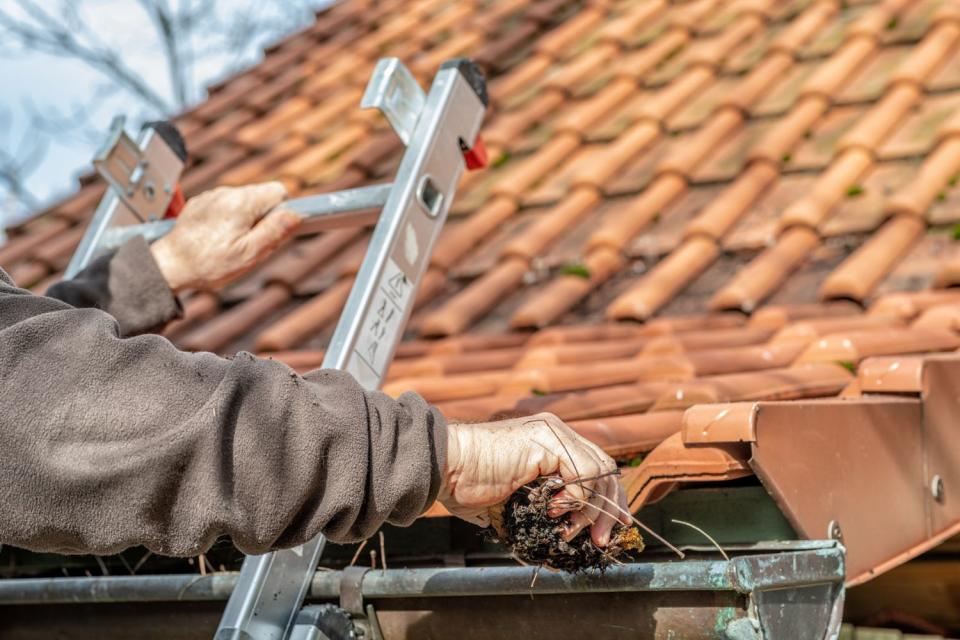How Much Does LeafGuard Cost?

Highlights
The average LeafGuard cost to install is $3,000 to $10,500.
Total labor and material costs for installing a LeafGuard system are determined by the size and amount of material needed, the accessibility of the gutters, the roof shape and pitch, labor rates, existing gutter removal, and other factors.
LeafGuard gutter guards reduce the need for annual gutter maintenance and help to better protect the home from water damage due to clogged gutters.
While some gutter guards can be installed by experienced homeowners, to ensure a LeafGuard product meets the requirements for the lifetime warranty, only a professional installer can install a LeafGuard system.
LeafGuard’s gutters are a sturdy one-piece design that comes with the gutter, gutter guard, and downspout. This system is designed to replace any existing gutters and to deter leaves and other debris from clogging up and preventing water from draining freely away from the home. For an estimated 150 linear feet, LeafGuard gutters cost between $3,000 and $10,500, with a national average of $6,800, according to HomeGuide.
Homeowners may wonder “How much does LeafGuard cost?” Factors that influence the final cost include the length and amount of material needed, the condition of the existing soffit and fascia, and the accessibility of the gutters.

Photo: istockphoto.com
Factors in Calculating LeafGuard Cost
LeafGuard cost is based on a number of factors, namely the gutter size and amount of material required based on LeafGuard gutters cost per linear foot. But other factors such as gutter accessibility and the roof shape and pitch can impact the labor costs. All of these affect the final cost of gutter guards. Other factors such as the geographic location and season during which the system is installed are also important considerations.
Gutter Size and Material
The size of the gutters and the amount of material needed are two of the most influential determining factors in how much a leaf-free gutter guard will cost. Gutters are measured in linear feet, and LeafGuard costs between $20 and $70 per linear foot on average. The longer the roofline, the higher the cost. Homeowners can consider limiting LeafGuard installations to protect only those parts of their home where leaves and debris are most prevalent.
Gutter Accessibility
The more accessible the gutters are, the faster the job will typically go. If gutters are difficult to access—tucked under tree branches or on steeply pitched or high roofs—the extra work can add time to the job, which can increase labor costs and, ultimately, the cost of the whole job.
Roof Shape and Pitch
Simple gable roof styles with a low to medium pitch are easier to access and work on than complex rooflines or those with a steep pitch. Installers must work more carefully on a roof with a steep pitch, which can cause a slower installation for safety reasons. For complex rooflines, the installers may have to make more cuts, which can make installation take longer. In both scenarios, labor and material costs will likely increase.
Labor
The final cost of LeafGuard will depend on the amount of labor needed for installation. For more complex jobs, the labor costs will likely be higher than for simple jobs that require less time. To help cut down on labor costs, homeowners can clear the area of any obstructions or trim trees that are close to the house.
If tree trimming is needed, professionals can do the job for about $50 to $125 per hour. Installing LeafGuard usually comes at a packaged price calculated by linear feet. An hourly rate for labor isn’t usually added as a separate line item, but homeowners can always verify if labor is included when they call for a quote.
Geographic Location
LeafGuard doesn’t have installation companies in every city. In some cases, the salespeople or installers can travel to a home for an in-person estimate or installation, but this could increase the cost of LeafGuard installation. The weather can also impact the timing of the installation process. For example, in areas that see lots of rain, installation may be delayed until there are dryer conditions.
Seasonality
Homeowners typically do many home improvement projects, including having leafless gutters installed in the spring and fall. This means that homeowners may be able to get a better price if they install a LeafGuard gutter system when installers are less busy in the summer or winter. The local climate will affect the season during which the gutters can be installed. In warmer climates, LeafGuard could be installed during winter, whereas winter installation is often impossible in colder climates.

Photo: istockphoto.com
Additional Costs and Considerations
Other costs and considerations to take into account when homeowners are choosing a system to prevent clogged gutters are the discounts and financing that the company offers; the cost of removing and disposing of existing gutters; any roof repairs, including soffit and fascia repairs; tree trimming to clear the area; and any other debris and ice prevention measures such as downspout extensions or gutter heaters.
Discounts and Financing
LeafGuard’s Offers page on the company’s website lists promotional offers available at any given time, though they may not be offered in all locations. Possible promotions include installation discounts, total cost discounts, or even gift card rebates.
LeafGuard offers financing through a Synchrony Bank credit card. The credit card typically requires a $29 activation fee but can offer a monthly payment price as low as $99 in some cases.
Existing Gutter Removal
LeafGuard is an all-in-one system that includes the gutter, gutter guard, and downspouts. This means that the existing gutters will need to be removed before the new system can be installed. The average cost for gutter removal is $3 to $4 per linear foot. Experienced homeowners can remove existing gutters themselves, which may cut down on installation costs.
It’s best for homeowners to ask the installation company if there are any special instructions or issues to watch for as they tear out the old gutters, though. LeafGuard will also take care of removing and disposing of the existing gutters, which can include recycling them to make new products.
Soffit and Fascia Repairs
To best protect a home from leaks and water damage, the soffit and fascia should be in good condition before any kind of rain gutter leaf guard is installed. In the event that the soffit or fascia needs to be repaired, it should be done before the LeafGuard gutter installation and will add to the total cost of LeafGuard gutter protection. Repairing damaged soffit and fascia costs around $5 to $12 per linear foot.
Gutter Service | Average Cost (Materials and Labor) |
Fascia repair | $600 to $6,000 |
Gutter cleaning | $119 to $228 |
Gutter repair | $193 to $620 |
New gutter installation | $622 to $1,677 |
Roof tail repair | $300 to $3,000 |
Downspout Extensions and Screens
Downspouts allow water to drain from the gutters and away from the house, but sometimes the end of the downspout is too close to the house, allowing water to pool and possibly run down the walls of the foundation. Downspout extensions fit onto the end of the downpipe and allow the water to drain farther from the home. They cost between $9 and $12and can add more drainage to the home.
Downspout screens fit into the top of the vertical pipe and prevent leaves and debris from clogging the system. A downspout LeafGuard system can reduce maintenance and allow for water to flow freely from the gutters to the ground. Screens cost between $6 and $12 depending on the style and the number that come with the pack.
Gutter Heaters
One advantage of gutter heaters is that they reduce the likelihood for ice to build up along the gutters and create an ice dam. This is important, since ice dams block the flow of water from the roof and can cause leaks and potential water damage. Gutter heaters are heated cables that are installed inside the gutter to prevent water from freezing solid. A gutter heater system costs between $500 and $1,300 but in colder climates makes a big difference in sections where the gutter gets little sunlight.
Tree Trimming
Removing tree branches that hang over or near the gutters can reduce the number of leaves that fall into them, reducing maintenance and the potential for leaks. With this in mind, tree trimming may be well worth the cost of $200 to $760. Tree trimming cost depends on the size and type of tree, the accessibility of the tree, the health of the tree, and the time of year. It’s also a good idea to trim trees before the gutter guard installers come, because it will make their job easier if they’re not working around low-hanging branches.

Photo: istockphoto.com
Benefits of Choosing LeafGuard Gutter Guards
The best gutter guards will offer a number of benefits. LeafGuard will keep gutters free of leaves and other debris, reducing the likelihood that water will leak into the home and cause water damage. LeafGuard gutter guards can also help homeowners avoid dangerous gutter cleaning scenarios, since debris doesn’t get trapped inside the gutter. Additionally, LeafGuard offers a lifetime transferable warranty, a customized fit, durability, reduced gutter maintenance, and debris protection.
Lifetime Transferable Warranty
LeafGuard’s Lifetime No Clog Warranty and Limited Lifetime Paint Finish Warranty states that the company’s products won’t “blister, flake, chip, crack, peel, split, rot, red rust, or structurally deteriorate as a direct result of manufacturing defect, under ordinary wear conditions” as long as they have been installed correctly. If any of these defects occur, the company will repaint, repair, or replace the LeafGuard system. The warranty doesn’t cover normal weathering, stains from environmental conditions such as tree sap or chimney fumes, or mildew, among other issues. The lifetime warranty can be transferred to subsequent owners of the property for continued protection.
Customized Fit
LeafGuard is a one-piece system that includes the gutter, gutter guard, and downspout. While the customized fit requires the removal of the existing gutter, it also helps to ensure the system is effective and free of any defects that could result from using the old gutters.
Durability
LeafGuard has an exclusive ScratchGuard paint finish that guarantees no chipping, peeling, or cracks, and it’s backed by the company’s Limited Lifetime Paint Finish Warranty. The system is also guaranteed to stay debris-free for the life of the home, or LeafGuard will come and clean it out at no cost. LeafGuard’s seamless one-piece design is also made from aluminum that’s 20 percent thicker than the industry standard and includes downspouts that are 30 percent larger than their competitors.
Reduced Gutter Maintenance
Typically, gutters should be cleaned once or twice a year to ensure leaves, sticks, dirt, and other debris aren’t building up in the gutters, which could lead to clogs. With LeafGuard, homeowners can worry less about the time and cost to clean their gutters. If they happen to notice a clog occuring, homeowners can call LeafGuard, and a company representative will come to clean and check the gutters at no cost.
Debris Prevention
LeafGuard’s system capitalizes on liquid adhesion, which naturally pulls the water around the guard and into the gutter while the gutter guards prevent pine needles, leaves, sticks, and other debris from getting into the gutters.

Photo: istockphoto.com
LeafGuard Installation: DIY vs. Hiring a Professional
If a homeowner feels confident in DIY gutter guard installation with another type or brand, the cost is typically between $615 and $2,348. However, there may be added costs if the roof or gutters need repairs. It’s also important to take into account the lifespan of DIY gutter guards. If they need to be replaced multiple times over the years, it may be worth it to choose a professional system that won’t need repeated replacement.
LeafGuard’s seamless one-piece system must be professionally installed by LeafGuard installers. While this makes the LeafGuard price higher than the price of DIY gutter guards, it also means that the system comes with a lifetime transferable warranty and a guarantee that the company will clean the gutters in the unlikely event that debris builds up and creates a clog. It is also safer than DIY installation, since it’s done by trained professionals.
How to Save Money on LeafGuard Cost
A LeafGuard system is an investment in the home’s maintenance, but there are still ways to save on the cost of the gutters and installation.
Keep the area accessible. Making installation as easy as possible can help reduce the overall price of the project. To do this, clear the way for the installers before they get there. That means moving any vehicles, furniture, toys, or other obstacles out of the way and trimming trees that hang over the gutters or block access.
Negotiate the price. In some cases, homeowners may be able to negotiate the final price by asking the salesperson or representative if there’s a way to reduce the cost. Homeowners can share their budget and ask if there are ways to make the price of the system fit. It’s possible that gutter guards are needed only on the part of the house that has trees nearby.
Remove existing gutters yourself. LeafGuard is a one-piece system that replaces existing gutters. Ask the representative if you can reduce the cost by removing the gutters prior to installation.
When cash isn’t readily available but you need a more permanent solution than annual gutter cleaning, you might see if the project can be covered through financing. One of the best home equity loans (such as one from U.S. Bank or Flagstar Bank) can help pay for an upgrade to LeafGuard gutters.
Questions to Ask About LeafGuard Installation
Removing existing gutters and replacing them with a LeafGuard system can be a large undertaking, though installation can often be done in a day. Asking the right questions can ensure that homeowners are comfortable with the process and don’t experience surprises.
What are the benefits of a LeafGuard system?
Will you offer a written quote? How long is it good for?
What will you do with my old gutters?
How long will installation take?
Do I need to be present during the installation?
Is there anything I can do to prepare my gutters for LeafGuard installation?
Can I save money if I remove the existing gutters myself?
What payment options and discounts do you offer?
What are LeafGutter customers’ reviews like?
How does LeafGuard compare against competitors such as LeafFilter, Leaf Shield gutter guards, Leaf Relief gutter guards, Leafree gutter guards, and Leafproof gutters?
FAQs
Installing a gutter guard system like LeafGuard can reduce gutter maintenance for homeowners and help prevent leaks and water damage to the home. Still, it’s no small project and can be a substantial investment for many homeowners. Asking the right questions can help make homeowners more comfortable with the process and the price. Here are a few answers to frequently asked questions that may help homeowners feel more confident about their decision.
Q. Are gutter guards and leaf guards the same?
Broadly speaking, gutter guards and leaf guards have the same result, but there are differences among the different types of gutter guards and leaf guards on the market. Some, like LeafGuard gutter guards, are one-piece designs, while others are three-piece designs. Some are standalone systems, while others attach to the existing gutters. The differences depend on the individual company, and the homeowner’s choice depends on what system works best for each home.
Q. How long does a leaf guard last?
The length of time a leaf guard lasts depends on the quality of the product. Some systems come with a lifetime transferable warranty, which means they’re guaranteed to last for the life of the home with no manufacturer defects. Other products may not come with a warranty and are likely a cheaper alternative, though they may need to be replaced sooner. LeafGuard gutter guards come with a Lifetime No Clog Warranty and Limited Lifetime Paint Finish Warranty to alleviate homeowners’ concerns about the quality and durability of their investment.
Q. What is a cheaper alternative to a LeafGuard?
A cheaper alternative to a LeafGuard system is regular cleaning and maintenance. Cleaning clogged gutters comes with a lower financial cost than installing gutter guards. But any project that involves working on a ladder can be dangerous, and a fall can lead to the need for expensive medical care. Cheaper DIY gutter guards can be installed on existing gutters, but they may not last as long as professionally installed systems like LeafGuard.
Q. Do LeafGuards overflow in heavy rain?
LeafGuard gutters are designed to handle 32 inches of rain per hour, and the competing Leaf Relief product is designed to drain 29.7 inches of rain per hour. This is significantly more rain per hour than is recorded even in the heaviest rainfalls.
Q. Can you buy a LeafGuard and install it yourself?
A LeafGuard-brand product must be installed by a licensed LeafGuard installer to ensure it qualifies for the warranties with proper installation. Other brands’ leaf guards and DIY gutter guards could be installed by the homeowner, and they’re typically less expensive than professionally installed leaf guards. However, they may not come with a warranty and may need to be replaced more frequently than gutters from brands like LeafGuard.
Q. What is the typical size of gutters?
Gutters are typically 5 inches wide at the top, or mouth, of the gutter. Some gutters can be as wide as 6 to 7 inches and hold more water than the standard 5-inch gutter. To determine the linear feet of gutters and get a good estimate for how many feet of gutters a home needs, take the total square footage of the house and divide it by 10.

